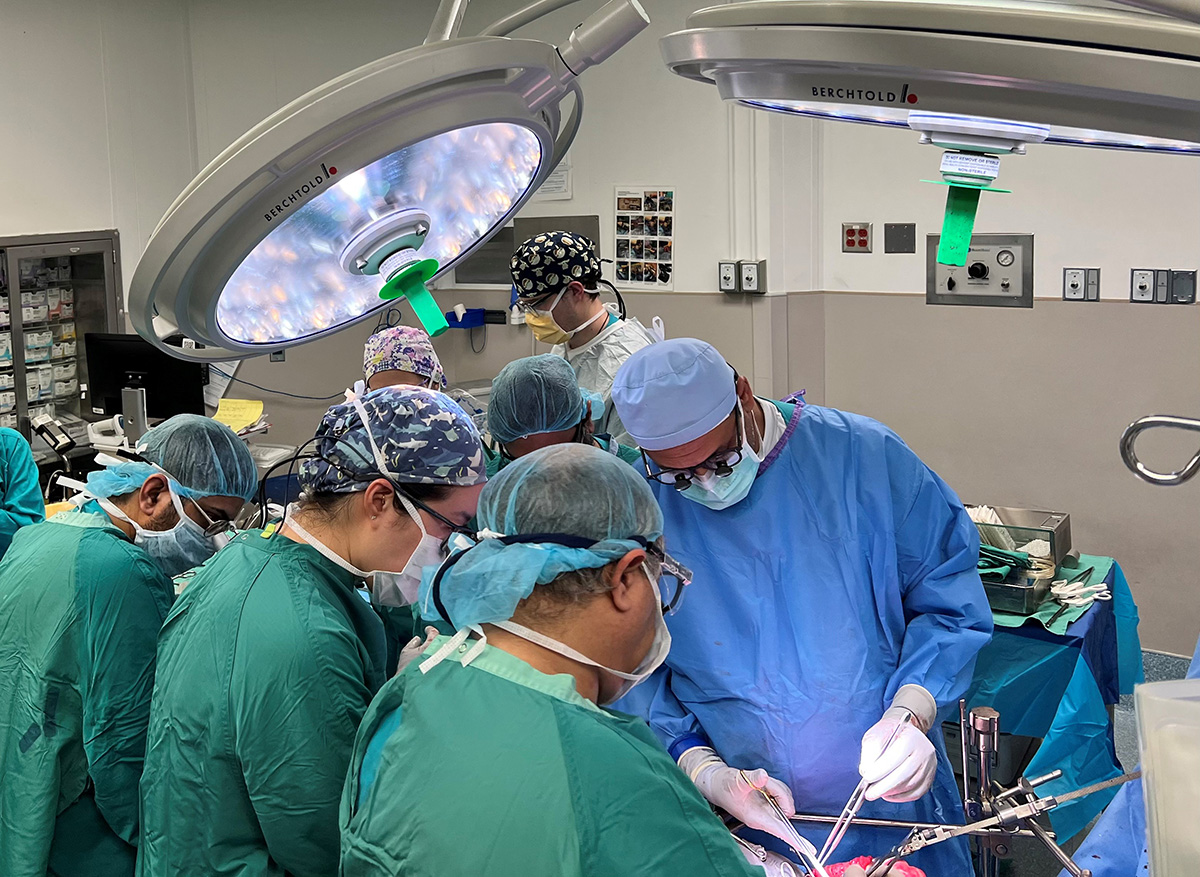A daughter’s gift: UNC Hospitals performs first living donor liver transplant in 20 years
Meredith Stiehl received a partial-liver transplant from her daughter Kenan, the first-ever living donor procedure at UNC Hospitals to be conducted in 20 years. Dr. Chirag Desai led the care team that performed the procedure.

The bond between a mother and daughter is quite special. This is particularly true for Meredith Stiehl, 57, who recently received a liver transplant from her 26-year-old daughter, Kenan Stiehl, to treat life-threatening liver disease.
In March, Dr. Chirag Desai, an abdominal organ transplant and hepatobiliary-pancreatic surgeon at UNC Hospitals and Dr. Sorabh Kapoor, an abdominal transplant surgeon in Carolina’s Department of Surgery, led a collaborative care team to perform the first liver transplant from a living donor at Carolina in almost twenty years.
“It is extremely satisfying to offer this treatment to our patient, who didn’t have to undergo prolonged suffering while waiting for a deceased donor liver,” said Desai, who is also the surgical director of the Liver Transplant Program at Carolina. “A living donor transplant enabled her to get this surgery done in optimal time and she has had a great outcome.”
Now that the precedent has been set, UNC Health has announced it has expanded its transplant services to include living donors – making it the second program in North Carolina capable of performing the procedure.
“We are so grateful to be the first,” said Meredith. “It feels like a miracle. The doctors, nurses, and transplant coordinator were just incredibly brilliant before, during, and after surgery.”
How does a living donor transplant work?
The liver is responsible for carrying out many vital duties within the body, from getting rid of harmful substances to producing proteins and making bile to digest food. Liver failure occurs when severe scarring, hepatitis, cancer, or other conditions prevents the liver from completing its tasks. Consequently, the body cannot function, and the patient’s life is at risk.
During a living-donor transplant, the recipient’s diseased liver is removed and replaced with a portion of a healthy liver from the living donor. Over time, the newly transplanted portion melds with the other half and slowly restores normal liver function in the recipient.
The remaining portion of the donor’s liver returns to its normal size, volume, and capacity within a couple of months after the surgery.
A daughter’s gift
For the previous eight years, Meredith’s quality of life had been on the decline. Her daily life and social interactions were disrupted when she began to experience the signs and symptoms of liver disease, including nausea, vomiting, weight loss and chronic fatigue. She lost 80 pounds since the onset of disease.
Meredith’s symptoms would occasionally get worse, forcing her to change plans and seek medical care for what she called a “tune up.” Dr. Jama M. Darling, a hepatologist at UNC Hospitals, asked Meredith if she would be open to receiving a new living-donor liver transplant under the supervision of Desai and Kapoor, two experienced liver transplant surgeons at UNC-Chapel Hill.
Meredith would need to find her own donor, and she was understandably hesitant about taking part in the new program at UNC. Her daughter, Kenan took the appropriate tests and discovered that she was a match for her mother’s liver transplant.
“I feel honored that I was able to do it,” said Kenan. “I just had to do it. I think it’s priceless to be able to help her and to have her for longer.”
One day, Kenan knocked on the door of the family’s Fayetteville home and surprised her mother with the development.
“I was amazed,” said Meredith. “I mean, my eyes were wide open. At that point, I was really ready to get my life back on track. I really did struggle with being very tired and not being able to take steps or even walk to the car.”

Dr. Desai, Dr. Kapoor and the rest of the abdominal transplant surgery team performing the partial liver transplant.
Living-donor transplants fulfill a greater need
For any eligible transplant recipients, like Meredith, receiving the gift of life from deceased donors feels like a miracle. In recent years, organs have been in higher demand than the deceased-donor supply can keep up with, which is why there’s a national transplant waiting list.
The waiting list arranges patients by the severity of their medical condition, which is known as a model of end-stage liver disease score. Ultimately, this leaves patients to wait while their condition worsens.
In 2020, a new national policy called the Acuity Circles Policy changed the way in which organs are shipped to hospitals throughout the United States, with many organs being exported from the state where the deceased donor had lived.
A new report listed North Carolina as one of the states seeing a mass exodus of organs, with only 1 in 100,000 eligible recipients receiving an organ transplant in 2021 under the new rule.
“Changes in the organ allocation policy have made it increasingly difficult for patients with a need for liver transplantation to receive a deceased donor transplant from the waitlist,” said Dr. Oren Fix,who is the medical director of liver transplant program.
“Living donor liver transplantation is an example of the innovative and patient-centered approach to patient care that Carolina’s liver transplant program offers to our community.”
Where the benefits outweigh the risks
Meredith spent just two weeks recuperating in the hospital following the partial liver transplant. She said she received “top-notch” treatment from the care team during that time. Now, six weeks after the surgery, her medical team has advised her to stay away from crowded areas.
“It’s been a dream so far,” said Meredith. “I had pain in the beginning from my Mercedes incision, but I’d say 95% of the discomfort is gone now. It’s so great to be able to socialize with friends and enjoy life again.”
A benefit of a living-donor transplantation is that it’s an elective surgery. Since living-donor recipients can sign up for surgery when they need it, they will not have to wait while their condition worsens, and their risk of complications increases.
Living-donor transplants have the best chances of success when the donor and recipient are biologically related, according to Kapoor.
“Living donor transplant allows us to minimize the time needed to transplant liver from one body to another,” said Kapoor. “These grafts are of the optimum quality because they are coming from the young, healthy donor. Surgery can be electively scheduled, which gives an advantage to the patients, family, and providers to optimize the conditions.”
This transplantation surgery was indeed successful because Kenan was young, healthy, and mentally strong enough to handle such a major surgery.
“I thought that I was pretty young and that my liver hasn’t gone through that much,” said Kenan. “I trust medicine and I love it. I think that’s why my automatic reaction was to volunteer for the surgery, aside from the love I have for my mom.”
There are risks of bleeding, swelling, and infection shortly after the procedure for the recipient and the donor, but there are no long-term complications associated with living donor transplantation. As for Kenan, living without a gallbladder is her biggest post-operative concern. Although she says she will miss eating hot Cheetos, she insists that she can definitely live without them.
Preparation and support is key
Once Meredith accepted Kenan’s desire to help, the Carolina transplant team conducted a variety of physical and psychological examinations to determine their readiness for surgery.
“There are so many questions and sacrifices that come with the surgery,” said Meredith. “And certainly, there’s a lot of things that I did not know about medicine. But, boy, they really prepare you and make sure you understand the process and what you’re getting into.”
She said the education and mental components really strengthened her confidence in going through with the surgery, as did the support of her husband, Robert. Whereas the donors do not undergo mental testing, they are provided support through patient care. Kenan was also supported by her boyfriend, Dan.
“There was one day where I had a mental breakdown,” Kenan said. “The nurses were just so solid. They were really my heroes.”
Moving Ahead for Doctor and Patient
Meredith is now ready to move forward with her life, family, and friends. Kenan is, too.
“I’m just excited for her to live a better quality of life now,” said Kenan. “That was the whole purpose. I think I did it for all the future moments and so that she would just feel better. It was so hard watching her be so sick.”
Kenan is also eager to begin her first job as an occupational therapist now that she is on the mend.
Above all, the living-donor transplant is a completely different procedure than a deceased-donor transplant. It requires two qualified, highly experienced surgeons who have the wherewithal to remove half of a liver from a healthy patient and insert it into a patient who has liver failure.
Both Dr. Desai and Kapoor feel that with the changing paradigm of allocation, the living donor liver transplantation is the future of liver transplantation.
“Since very few programs in the country have this expertise, we are happy to offer this opportunity to the residents of North Carolina. Our plan is to expand our outreach to those in need statewide,” says Desai.
UNC Hospitals has now performed its second living-donor liver transplant, and staff are poised to build the program into a leading site in the nation.




